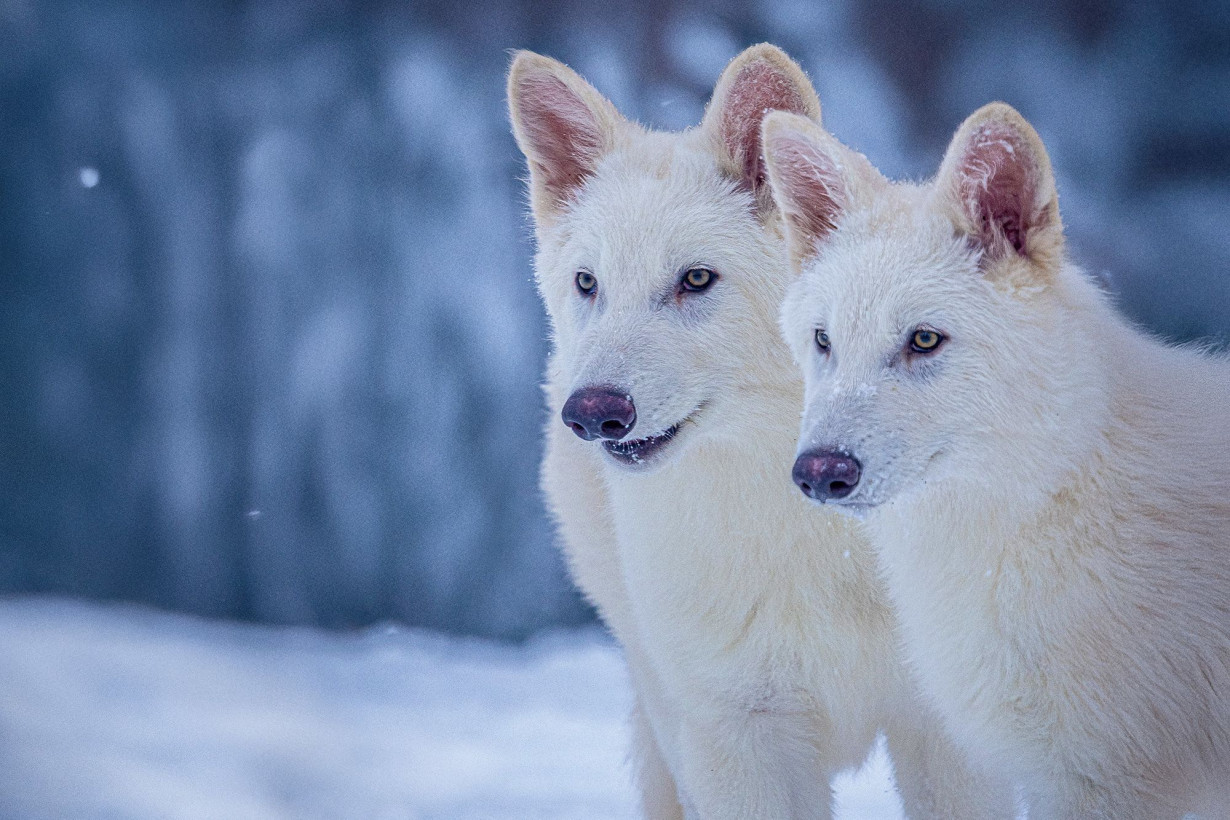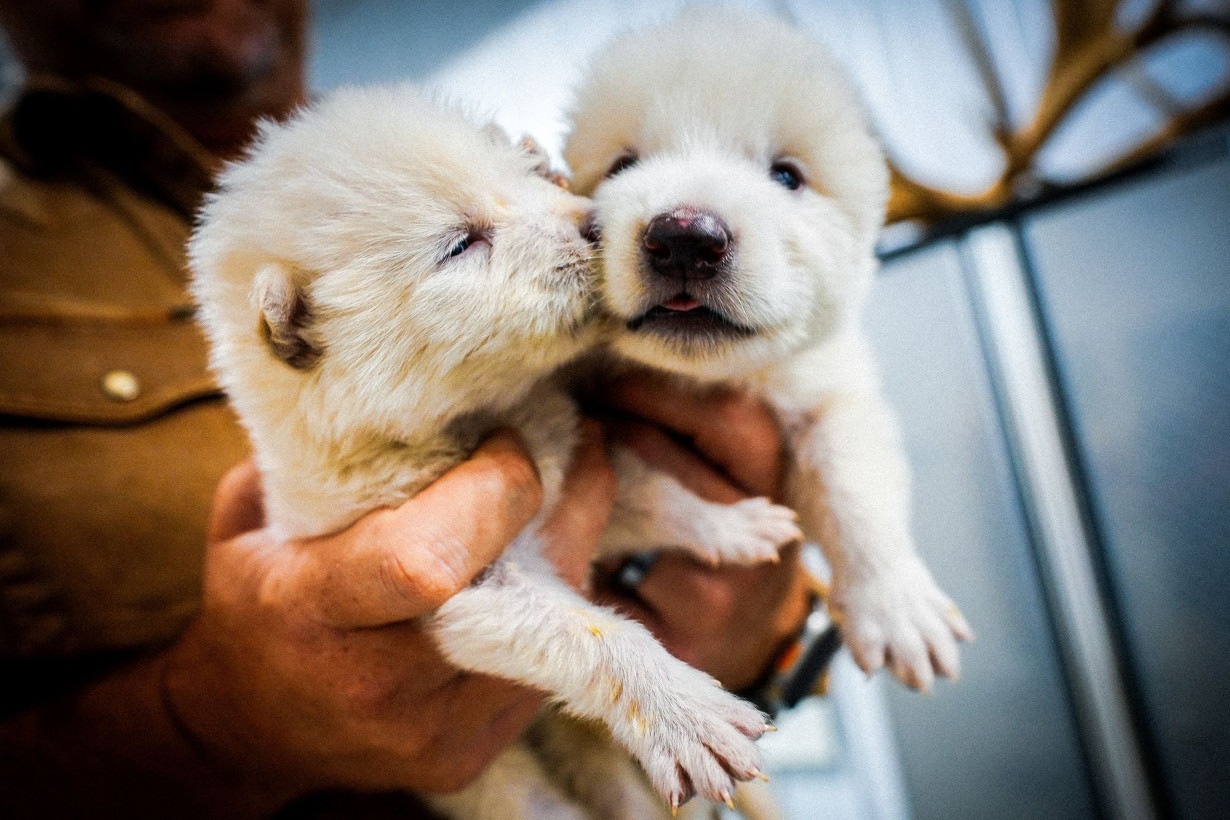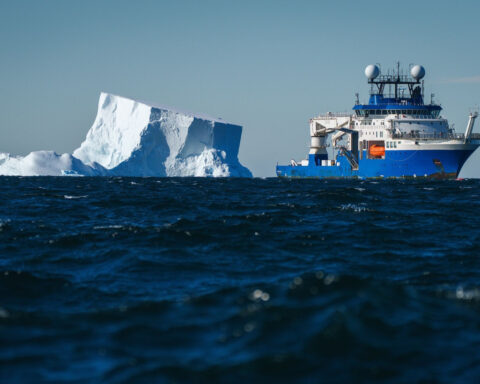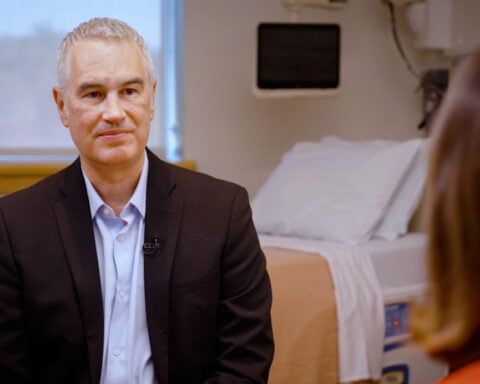(CNN) — A species of wolf that died out some 12,500 years ago lives again as the “world’s first successfully de-extincted animal,” according to Dallas-based biotech company Colossal Biosciences.
Colossal scientists have created three dire wolf pups by using ancient DNA, cloning and gene-editing technology to alter the genes of a gray wolf, the prehistoric dire wolf’s closest living relative, the company announced Monday. The result is essentially a hybrid species similar in appearance to its extinct forerunner.
The dire wolf, Aenocyon dirus, which was the inspiration for the fearsome canine featured in the HBO TV series “Game of Thrones,” was a top predator that once roamed North America. (HBO shares parent company Warner Bros. Discovery with CNN.) Dire wolves were larger in size than gray wolves and “had a slightly wider head, light thick fur and stronger jaw,” the company said.

Colossal has been working toward resurrecting the mammoth, dodo and Tasmanian tiger since 2021, but the company had not previously publicized its work on dire wolves.
“This massive milestone is the first of many coming examples demonstrating that our end-to-end de-extinction technology stack works,” said Ben Lamm, Colossal’s cofounder and CEO, in a news release. “Our team took DNA from a 13,000 year old tooth and a 72,000 year old skull and made healthy dire wolf puppies.”
The three dire wolves are living on a 2,000-acre site at an undisclosed location enclosed by 10-foot-tall (3-meter-tall) “zoo-grade” fencing, where they are monitored by security personnel, drones and live camera feeds. Colossal said the facility had been certified by the American Humane Society and registered with the US Department of Agriculture.
Dire wolf fossils and ancient DNA
Using ancient DNA extracted from two dire wolf fossils, Colossal’s scientists and collaborators said they were able to assemble two high-quality Aenocyon dirus genomes, or complete sets of genetic information.
The team compared the genomes with those of living canids such as wolves, jackals and foxes to identify the genetic variants for traits specific to dire wolves, such as white coats and longer, thick fur. Dire wolves and gray wolves shared 99.5% of their DNA, according to the company’s news release.
“We aren’t trying to bring something back that’s 100% genetically identical to another species. Our goal with de-extinction is always create functional copies of these extinct species. We were focusing on identifying variants that we knew would lead to one of these key traits,” Beth Shapiro, Colossal’s chief science officer told CNN.
The company then used the information from the genetic analysis to alter gray wolf cells, making 20 edits in 14 genes before cloning the most promising cell lines and transferring them into donor eggs from domestic dogs.
“So we can take these eggs and we remove the nucleus, and then you insert the nucleus that we’ve edited from that gray wolf cell, and that is what we clone,” Shapiro, who is currently on a leave of absence from her role as professor of ecology and evolutionary biology at the University of California, Santa Cruz, explained.
Healthy developed embryos were then transferred into domestic dogs — specifically large, mixed-breed hounds — that acted as surrogate moms, Shapiro said. Researchers completed eight transfers in total, with average of 45 embryos on each attempt.
Two male dire wolf pups were born on October 1, 2024, while a female pup was born on January 30, 2025, according to Colossal Biosciences.
“When we found out that we had singleton puppies in each of those litters eventually, that was actually maybe not the optimal outcome, but it’s pretty optimal,” said Matt James, Colossal’s chief animal officer. “We didn’t want to suddenly have 25 dire wolves on our hands, right? That would have been really hard to manage.”
James said the pups were “habituated to people” but not tame. The two older, male dire wolves are “exploring more and more of their habitat every day” but come back to base for feeding twice a day. He said he hopes to “grow the pack” in the future.
“We’re still seeing a lot of juvenile behaviors. I think they are much more standoffish, much more skittish (than gray wolves). We haven’t seen them really fully express all of their behavior. They’re still juvenile — when they get that testosterone surge, I think we’ll see a lot of interesting behavior,” he said.
“They’re an amazing opportunity for us to learn tons and tons about de-extinction, about cloning, about genetic editing and all the effects after that.”
Gene editing for de-extinction
To achieve its goal, the company essentially created a hybrid genome using CRISPR technology to cut away certain gray wolf gene variants and replace them with traits associated with dire wolves, said Love Dalén, a professor in evolutionary genomics based at the Centre for Palaeogenetics at Stockholm University, and an adviser to Colossal.
“There’s no secret that across the genome, this is 99.9% gray wolf. There is going to be an argument in the scientific community regarding how many genes need to be changed to make a dire wolf, but this is really a philosophical question,” Dalén said.
“It carries dire wolf genes, and these genes make it look more like a dire wolf than anything we’ve seen in the last 13,000 years. And that is very cool.”
Dalén, who said he had been “a little bit” involved in the analysis of the dire wolf genomes but had not personally met the dire wolf pups or been involved in the gene editing or cloning process, said the work by the scientists was a “huge leap” from anything done in the field in the past.
“The way I see this is that they have resurrected the dire wolf phenotype (the observable traits of a species) and we know from the genome that they probably looked a bit like these puppies. To me, it’s a dire wolf in that sense,” he said.
The debate over whether the wolves are a carbon copy of their extinct forerunners misses the point, Shapiro said, adding that the team had been successful in resurrecting the “functional essence” of the dire wolf.
“I recognize that the scientific community is saying, ‘Oh, it’s not genetically close enough to a dire wolf.’ These classifications are human constructs. They’re useful frameworks for talking about things, but they’re tools, not truths, right? And we successfully identified 20 precise genetic variants,” she said. “It’s not very much, but we did, (and in) doing that, resurrected these key differences in the way these animals look.”
Colossal has raised at least $435 million since Lamm, a serial entrepreneur, and Harvard University geneticist George Church, founded the company in September 2021 and first announced plans to resurrect the mammoth. That endeavor has taken longer than Lamm initially projected, with the company saying it’s on track to introduce the first woolly mammoth calves in 2028.
De-extinction and conservation
The company hopes the technologies that created the dire wolf can directly help endangered animals as well. Colossal said on Monday it has produced two litters of cloned red wolves, the most critically endangered wolf species, using a new, less invasive approach to cloning developed during the dire wolf research.
“The red wolf… is a great example of a species that’s hindered by a lack of genetic diversity. What what we could do, is begin to use this technology to reintroduce founders into a population in a way that would enhance genetic diversity, the robustness, the adaptability of a recovery program,” James said.
Colossal is correct to argue that their technology is suitable to contribute to conservation of threatened species, said Michael Knapp, an associate professor in the department of anatomy at the University of Otago in New Zealand.
Other potential uses include “editing harmful mutations out of the populations of threatened species and introducing traits that may help rare species adapt to environmental change,” Knapp said.
“On the other hand, the technology still has its limitations,” he added. “Genes that may be introduced to give a species more fur, might have other and unwanted functions as well. Also, often not only the species, but the ecosystems they used to live in are extinct.”
Many critics of de-extinction argue that the huge sums of money invested in the project could be better spent elsewhere — and that raising and breeding the hybrid creatures could imperil living animals used as surrogates. However, Christopher Preston, a professor of environmental philosophy at the University of Montana, said Colossal appears to be paying attention to animal welfare issues, noting the size of the facility and support from the American Humane Society.
“Colossal have taken thoughtful precautions to screen against any unintended genetic consequences of their edits, eliminating risky edits known to be associated with poor outcomes,” he added.
But he said it’s hard to imagine the dire wolves playing a role in an ecosystem, an outcome the company has said is the ultimate goal of its efforts to create genetically engineered mammoth-elephants.
“In states like Montana, we are currently having trouble keeping a healthy population of gray wolves on the land in the face of amped up political opposition,” Preston said. “It is hard to imagine dire wolves ever being released and taking up an ecological role. So, I think it is important to ask what role the new animals will serve.”
The-CNN-Wire
™ & © 2025 Cable News Network, Inc., a Warner Bros. Discovery Company. All rights reserved.

 Trump has begun another trade war. Here's a timeline of how we got here
Trump has begun another trade war. Here's a timeline of how we got here
 Canada's leader laments lost friendship with US in town that sheltered stranded Americans after 9/11
Canada's leader laments lost friendship with US in town that sheltered stranded Americans after 9/11
 Chinese EV giant BYD's fourth-quarter profit leaps 73%
Chinese EV giant BYD's fourth-quarter profit leaps 73%
 You're an American in another land? Prepare to talk about the why and how of Trump 2.0
You're an American in another land? Prepare to talk about the why and how of Trump 2.0
 Chalk talk: Star power, top teams and No. 5 seeds headline the women's March Madness Sweet 16
Chalk talk: Star power, top teams and No. 5 seeds headline the women's March Madness Sweet 16
 Purdue returns to Sweet 16 with 76-62 win over McNeese in March Madness
Purdue returns to Sweet 16 with 76-62 win over McNeese in March Madness








